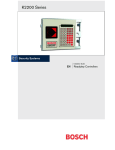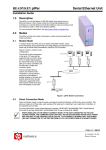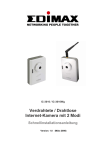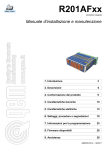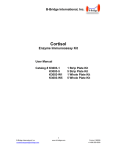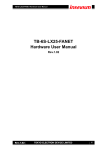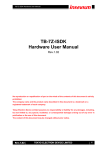Download Bosch K2200 Series Installation guide
Transcript
READYKEY K3000 / D8300 Series KeyPAC Readers Operation & Installation Guide Figure 1: Low Profile (K3001 / D8301) Figure 2: Vandal Resistant (K3002 / D8302) Figure 3: Mullion (K3003 / D8303) 1.0 Introduction These readers read KeyPAC ID-devices including ISO thickness ID cards. They do not read the earlier K2000 / D8200 series ID devices. Make sure that you specify KeyPAC whenever you buy ID devices. 1.1 Part Numbers K3001 / K3001W and D8301 are KeyPAC Low Profile Readers K3002 / K3002B and D8302 are KeyPAC Vandal Resistant Readers (Stainless Steel or Brass) K3003 / K3003W and D8303 are KeyPAC Mullion Readers Note: The K3000 Series readers are available to Readykey Dealers only. 1.2 Compatible ID Devices The KeyPAC range will not work with the older Readykey ID devices. The following are part codes for compatible ID devices: Part Number K3011-10 K3011M-10 K3010-10 K3011WG-10 / D8339-10 3010WG-10 / D8338-10 Description KeyPAC ISO Thickness Card (pack of 10) KeyPAC ISO Thickness Card with Magnetic Stripe (pack of 10) KeyPAC Tokens (pack of 10) KeyPAC Cards with Wiegand Stickers (pack of 10) KeyPAC Tokens with Wiegand Stickers (pack of 10) Table 1: Compatible ID Devices Note: The K3000 Series Devices are available to Readykey Dealers only. 2.0 Overview 2.1 Description Each reader may be mounted internally or externally without any special weather protection, however the Vandal Resistant Reader is better suited to outdoor use. Other important features include: • • • • • Suitable for mounting on metallic and non-metallic surfaces Integral red/green LED Tamper protection Low idle current consumption Integral sounder (not Vandal Resistant) 17404 Ver 2.4/47556B K3000 / D8300 Series • 2.2 Output format selection. Formats available are Readykey format (default), Wiegand (26 and 34bit), Magstripe and Barcode Specifications Appropriate Reading Range for ISO Thickness Card Power Requirements Environmental K3001 Low Profile 0 in. – 4 in. (0 cm – 10 cm) K3002 Mullion 0 in. – 3 in. (0 cm – 7.6 cm) K3003 Vandal Resistant 0 in. – 2 in. (0 cm – 5.1 cm) These ranges will reduce if the readers are mounted on surfaces containing metal or if they are near local sources of electrical noise. Mullion 12 VDC (nominal), < 40 mA; Tolerance +10.5 V to +20 V Low Profile and Vandal 12 VDC (nominal), < 85 mA; Resistant Tolerance +10.5 V to +20 V Operating -31ºF to + 140ºF (-35 ºC to + 60ºC); 0-90% RH at 86ºF±5ºF (30ºC ±2ºC) for 24 hrs Storage -31ºF to +176ºF (-35ºC to +80ºC) Ingress Protection Sealed to IP 66 Table 2: K3000 / D8300 Series Specifications 3.0 Installation 3.1 Unpacking Check that all the parts are supplied with your reader. If anything is missing or damaged, contact your suppliers immediately. The readers are each supplied with the following: Low Profile Mullion Vandal Resistant Two screws Two 1” screws Four Screws Snap fit decor cover Snap fit decor cover Label Label Label Ten cable crimps Ten cable crimps Ten cable crimps MOV MOV MOV Table 3: K3000 / D8300 Series Supplied Parts 3.2 Output Format Selection You can set the output format before installing the reader or at any point before power is connected. The instructions given here do not contradict those in the wiring section they are only necessary for programming the output format before the reader is wired as normal. The default output format for this unit is Readykey. To set the reader to other output formats: Disconnect the power before starting. Failure to do so may damage the unit. Start with all the wires disconnected from the reader. 1. To select the output Output Format format twist together the wires as shown in Normal power up the following table: Readykey (default) Wiegand 26-bit Wiegand 34-bit Magstripe Barcode 2. 3. Note: 4. 5. Brown to… Yellow to… # of Flashes on power up all separate white - green white green green green white Table 4: Output Format Selection Separate the other wires and keep them separate. We suggest you use insulation tape. 0 1 2 4 5 Connect the power for 2 seconds. Connect the black wire to GND (ground) and the red to power +12 V (10.5 V to 20 V). At this stage there will be no indication of successful format change. Disconnect the power. Untwist the wires and keep them separate, again we suggest you use insulation tape. K3000 / D8300 Series KeyPAC Readers Operation & Installation Guide 17404 Ver 2.4/47556B (7/01) Page 2 © 2001 Radionics K3000 / D8300 Series 6. 3.3 To check that you were successful, reconnect the power using the red and black wires (as above) and count the number of green LED flashes. The format can be determined according to the table above. MOV - Lock Suppression A metal-oxide-varistor (MOV) is provided with each KeyPAC reader. This device prevents back EMF (high voltage 'spikes') being returned from the electric lock to the unit. High voltage spikes can cause severe damage over a period of time, and erratic operation of the system if not controlled. Failure to fit the MOV at the lock will result in early failure of the unit. It will also invalidate the warranty. The MOV (A) should be fitted across the power terminals of the lock (B). + A A B Figure 4: MOV Installation 3.4 Before Installing the Reader Be aware of the following when you choose the locations of your readers: • • • • • • • • • • 3.5 Installing the Reader 1. 2. 3.6 The cable distance from controller to reader should never exceed 3,000 feet (1000m) (with appropriate cable). Also consider the maximum distance between the controller and the lock. If you use a Request To Exit (RTE) switch, route the wiring so that it is not accessible if the reader is removed. Ensure that the LED is visible to the keyholder. The best place for a reader is next to the door on the unhinged side at roughly the same height as the door handle. Check local regulations for ADA compliance. Readers may be located inside or outside. Leave enough room behind the reader for the flying lead. Readers can be mounted behind a non-metallic material, such as glass, plastic or wood without affecting their reading range. There should be a minimum 3 ft (1m) distance between readers (this includes in and out readers on opposite sides of a door). Readers can read in the same way from their back as they do from their front. Because of this, ID devices may work from the other side of the wall on which the reader is mounted. Avoid mounting the reader in direct sunlight. Make sure the reader cable is not connected to the controller. Route the flying lead behind the reader and connect it using the crimp connectors supplied. Wire the cable as described in the Wiring section later in this manual. If the connections are in a location that may be wet or damp, then protect the connectors with a sealing compound, or use weatherproof crimps. 3. Using appropriate fixings, such as wall plugs, for the surface you are mounting it on, fix the reader to a flat surface using the screws provided. Install the reader onto a flat and even a surface as possible, as this will reduce the possibility of it being levered from a wall. 4. For the K3001 and D8301: the two holes are 2.4 in (60 mm) apart. Use the round hole first, then the oval hole to ensure the reader is straight. Once the reader is mounted in place then the snap-fit décor cover can be snapped into place. The hole in the cover should line up with the LED. Place the label on the front of the reader. 5. For the K3002 and D8302 Vandal resistant readers, apply a silicone sealant to any gaps behind the reader to protect against moisture if the reader is mounted outside. User the Vandal Resistant screws provided or other suitable fasteners. The LED should be at the top. Removing the Reader The K3001 and D8301 readers can be removed by placing a small flat-bladed screwdriver into the apertures at the edges of the snap-fit cover. Take care not to damage the reader or cover. © 2001 Radionics K3000 / D8300 Series KeyPAC Readers Operation & Installation Guide Page 3 17404 Ver 2.4/47556B (7/01) K3000 / D8300 Series 4.0 Wiring All connections are made to a 3 ft (1 m) flying lead. 10 cable crimps are included for joining connectors to the cable from the controlling system. Cable gauge depends on distance from the door controller to reader. When using 0.22 mm² (24 AWG) cable, you should twist the wires together and double them over before inserting them in the crimp. Flying Lead Readykey Wiegand Controller Black White Green SIG N/A DATA1 DATA0 Brown Yellow Red Blue Tamper Magstripe Controller GND DATA CLK Barcode Controller SIGNAL Not Connected (Crimp) VCA / LED – GND to activate Sounder – GND to activate 12 VDC (+10.5 to +20 V) -V Not Connected (Crimp) Table 5: Wiring Connections 4.1 Wire Gauges and Cable Lengths (Readykey Equipment Only) 7/0.2 16/0.2 32/0.2 Cable Gauge 0.22 mm² 24 AWG (0.6 mm) 0.5 mm² 20 AWG (1.0 mm) 1.0 mm² 18 AWG (1.2 mm) Distance (reader to door controller) Up to 750 feet (250 meters) Up to 1500 feet (500 meters) Up to 3000 feet (1000 meters) Table 6: Readykey Wire Gauges and Lengths 4.2 Standard Wiring Diagram for Readykey Controllers (only) Door controllers to KeyPAC readers. Always refer to your controller manual. Note: The Readykey K2200 series controllers allow the connection of two readers to each channel, only if both readers’ outputs are set to Readykey output format. Sounder Switch N/O Reader Door Controller Door Contact N/C -V or GND SIG DC or DR1 RTE or DR2 LED +V Yellow Blue Black White Brown Red SOUNDER TAMPER 0V SIG VCA/LED +12V N/O Request to Exit Figure 5: Standard Wiring Diagram 5.0 Operation The reader LED will normally be red when the door is locked. When a key is presented within range of the reader, and the key is valid for that door at that time, the LED will go green and the lock will release. The LED will stay green while the lock is released. 5.1 Tamper Protection (Readykey format) To ensure complete tamper protection the DR1 or DC terminal of the door controller should be connected to the blue lead of the reader. If a door contact is being used then this should be connected in series with DR1/DC and the blue lead. See the door controller installation manual for full details of how to set up tamper protection and alarm monitoring. 5.2 Sounder Operation (not Vandal Resistant) The internal sounder will operate if the yellow lead is grounded. The sounder will continue until the connection to ground is broken. A relay, such as provided on the Readykey K2200 series controllers, may be used to provide this operation under various conditions, e.g. Door Left Open. Note: The yellow wire is retained for the vandal resistant reader to allow the installer to set the output format. ID devices will not be read while the sounder is operating. © 2001 Radionics, a division of Detection Systems, Inc. PO Box 80012, Salinas, CA 93912-0012, USA Customer Service: (800) 538-5807 17404 Ver 2.4/47556B Operation & Installation Guide 7/01 K3000 / D8300 Series Page 4 of 4





